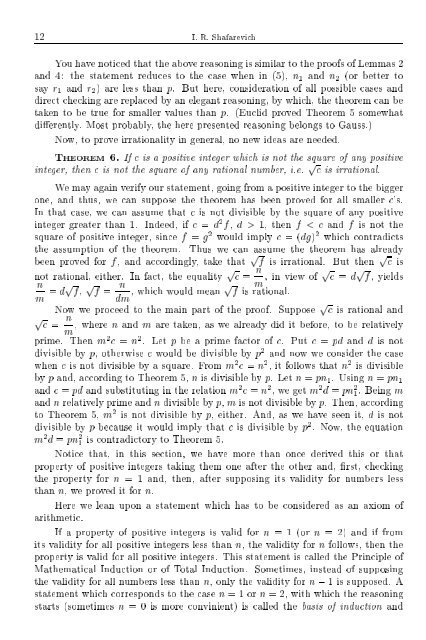SELECTED CHAPTERS FROM ALGEBRA I. R. Shafarevich Preface
SELECTED CHAPTERS FROM ALGEBRA I. R. Shafarevich Preface
SELECTED CHAPTERS FROM ALGEBRA I. R. Shafarevich Preface
You also want an ePaper? Increase the reach of your titles
YUMPU automatically turns print PDFs into web optimized ePapers that Google loves.
12 I. R. <strong>Shafarevich</strong>You have noticed that the above reasoning is similar to the proofs of Lemmas 2and 4: the statement reduces to the case when in (5), n 1 and n 2 (or better tosay r 1 and r 2 ) are less than p. But here, consideration of all possible cases anddirect checking are replaced by an elegant reasoning, by which, the theorem can betaken to be true for smaller values than p. (Euclid proved Theorem 5 somewhatdierently. Most probably, the here presented reasoning belongs to Gauss.)Now, to prove irrationality in general, no new ideas are needed.THEOREM 6. If c is a positive integer which is not the square of any positiveinteger, then c is not the square of any rational number, i.e. p c is irrational.We may again verify our statement, going from a positive integer to the biggerone, and thus, we can suppose the theorem has been proved for all smaller c's.In that case, we can assume that c is not divisible by the square of any positiveinteger greater than 1. Indeed, if c = d 2 f, d > 1, then f < c and f is not thesquare of positive integer, since f = g 2 would imply c =(dg) 2 which contradictsthe assumption of the theorem. Thus we can assume the theorem has alreadybeen proved for f, and accordingly, take that p f is irrational. But then p c isnot rational, either. In fact, the equality p c = n m , in view of p c = d p f, yieldsnm = dp f, p f =ndm ,whichwould mean p f is rational.Now we proceed to the main part of the proof. Suppose p c is rational andp n c = , where n and m are taken, as we already did it before, to be relativelymprime. Then m 2 c = n 2 . Let p be a prime factor of c. Put c = pd and d is notdivisible by p, otherwise c would be divisible by p 2 and now we consider the casewhen c is not divisible by a square. From m 2 c = n 2 , it follows that n 2 is divisibleby p and, according to Theorem 5, n is divisible by p. Let n = pn 1 . Using n = pn 1and c = pd and substituting in the relation m 2 c = n 2 ,wegetm 2 d = pn 2 1. Being mand n relatively prime and n divisible by p, m is not divisible by p. Then, accordingto Theorem 5, m 2 is not divisible by p, either. And, as we have seen it, d is notdivisible by p because it would imply that c is divisible by p 2 . Now, the equationm 2 d = pn 2 1is contradictory to Theorem 5.Notice that, in this section, we have more than once derived this or thatproperty of positive integers taking them one after the other and, rst, checkingthe property for n = 1 and, then, after supposing its validity for numbers lessthan n, weproved it for n.Here we lean upon a statement which has to be considered as an axiom ofarithmetic.If a property of positive integers is valid for n = 1 (or n = 2) and if fromits validity for all positive integers less than n, thevalidity forn follows, then theproperty isvalid for all positive integers. This statement is called the Principle ofMathematical Induction or of Total Induction. Sometimes, instead of supposingthe validity for all numbers less than n, onlythevalidity forn ; 1 is supposed. Astatement which corresponds to the case n =1orn =2,withwhich the reasoningstarts (sometimes n = 0 is more convinient) is called the basis of induction and
















